
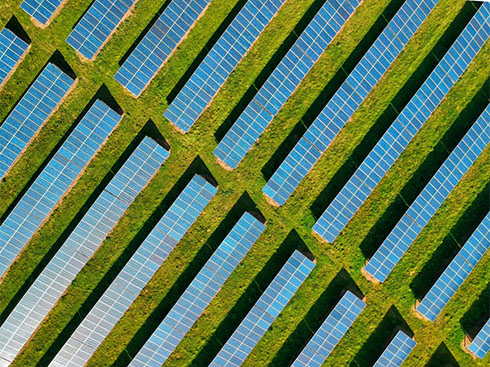
In recent years, the United States has made substantial progress in embracing the renewable energy revolution, positioning itself on the path to a more sustainable future. This shift is driven by a variety of factors including environmental concerns, economic opportunities and technological advances. With the Inflation Reduction Act (IRA) and the Bipartisan Infrastructure Act (BIL), the United States is accelerating its move toward clean energy solutions. In 2022, the share of renewable energy sources (RES), including hydropower, in the country's electricity generation has reached approximately 22%; furthermore, the share of RES in total electricity generation has increased to approximately 30%. It is worth noting that in the transportation sector, consumers are also becoming more aware and increasingly choosing zero-emission fuels such as electric vehicles. EUPD Research estimates that battery electric vehicles (BEVs) will account for 5.6% of new car registrations in 2022, with this share having surged to 7.1% in the first half of 2023. The United States has ambitious goals, including achieving 100% carbon pollution-free electricity by 2035 and striving to achieve economy-wide net-zero greenhouse gas emissions no later than 2050. The targets are expected to provide a major boost to the clean energy industry in the country, further strengthening its commitment to a sustainable and environmentally responsible future.
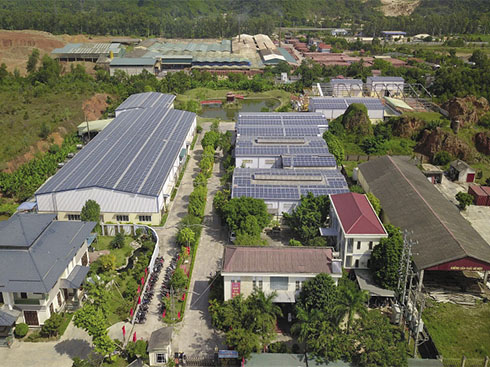
Vietnam's Ministry of Transport said last week it was receiving feedback on a new draft decree to encourage rooftop solar power. According to the draft, rooftop solar energy will be integrated into the national grid for self-use, but cannot be sold to other organizations or individuals or fed back to the grid. While this has a negligible impact on independent power producers managing commercial and industrial projects, it sends another rather negative signal for solar development in the country. According to local media reports, the Ministry of Industry and Information Technology first proposed in August that it would propose an amendment to rooftop solar power, aiming to promote the development of self-consumption of rooftop solar power. In May, the Vietnamese government announced it would invest $135 billion in an energy strategy aimed at equipping half of the country's residential rooftops with photovoltaic power generation projects under a net metering scheme and making Vietnam a net exporter by the end of the decade, a key key to the strategy. pillar. According to the latest data provided by the International Renewable Energy Agency (IRENA), Vietnam's installed solar capacity at the end of last year was 18 GW.
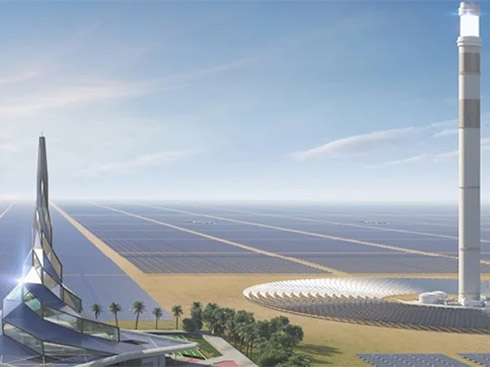
A 950 MW solar complex has been inaugurated in Dubai, host of the COP28 climate change conference. The hybrid facility consists of the most powerful concentrated solar power (CSP) system and photovoltaic installations on Earth. This is the fourth phase of the Mohammed bin Rashid Al Maktoum Solar Park, which is vying for the title of the largest solar park in the world. Phase 4 includes the world's largest concentrated solar power facility with a total installed capacity of 700 MW and 250 MW of photovoltaic power generation capacity. The Mohammed bin Rashid Al Maktoum Solar Park is expected to generate 5 gigawatts of electricity. Currently, even without CSP, its total installed capacity reaches 2.6 GW, making it one of the few largest installed capacities on the planet. The entire system will include heat and green hydrogen. Dubai Electricity and Water Authority (DEWA) said the concentrated solar power segment features a record-high number of solar towers and the largest thermal energy storage capacity. The utility controls 51% of the Noor Energy 1 joint venture, which is building the fourth phase of the project. Co-owners are Saudi Arabia's ACWA Power (25%) and China Silk Road Fund (24%). The fourth phase of the project is worth US$4.3 billion. According to DEWA, the CSP facility has a 600 MW parabolic basin complex and a 100 MW 263-meter-tall solar tower. Additionally, it cited Guinness World Records as saying that it has the largest thermal energy storage capacity at 5.9 GWh. The fifth phase of the project has been put into use this year.
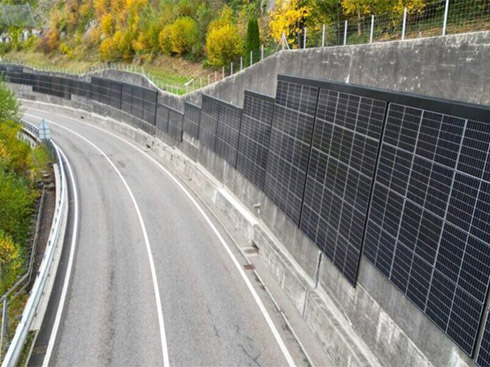
A consortium consisting of German installation system supplier K2 Systems and Swiss EPC contractor Solarmotion has deployed a vertical photovoltaic system on a detour road in the city of Toifen in the canton of Apenzell, Switzerland. The array is installed on a retaining wall with a slope of 75 degrees and an installed capacity of 325kW. This array uses 756 dual glass all black solar modules provided by an undisclosed supplier. K2 Systems states that the installation solution for this device uses "K2 BasicRail" mounting rails and HUS screw anchors. Hilti, located in Liechtenstein, provided mechanical pins for the project. In the system configuration, adhesive technology is used to fix the components of the photovoltaic system and the K2 building protection pad as the substrate onto the masonry. In order not to affect the statics of the retaining wall, the company must consider that the anchoring depth must not exceed 90mm. The engineering office of the Swiss Road Supervision Agency inspected all static calculation results during the planning phase. The company has completed this project within two months. Due to its proximity to asphalt, the K2 installation system still needs to meet special corrosion requirements, and its components are covered with anodized aluminum oxide for protection. The components of the fastening system are made of aluminum alloy and A2 stainless steel materials. The photovoltaic system is scheduled to be officially put into use in December. It is expected that the vertical array will achieve good output, especially in winter. Overall, it is expected that the annual solar power generation will be around 230000 kWh.

Latest statistics from Italian energy agency Gestore dei Servizi Energetici (GSE) show that Italy added about 3.5 GW of new photovoltaic capacity through about 280,000 systems in the first nine months of this year. As of the end of September 2023, the country's cumulative installed photovoltaic power generation capacity reached 28.57 GW. Of this, approximately 8.44 GW is rooftop installed capacity, while the remaining 16.61 GW comes from ground-mounted PV arrays. About 46% of new power generation capacity in the first nine months of this year was residential solar power generation, and recent additions have mainly come from commercial and industrial (C&I) and utility-scale projects above 1 MW.

The Irish government announced last week that from today around 1,600 schools in Ireland can apply to install 16 solar panels on their roofs, equivalent to 6kW of solar power. The Department for Education, which is leading the programme, said the programme, called the Solar for Schools programme, aims to enable Ireland to meet its climate targets and help schools reduce their energy bills. The Irish government said the panels at the school will be connected to the grid and can share energy with neighbors during closures such as school holidays. The school expects to save approximately €1,200 to €1,600 ($1,311 to $1,748) per year through the program, with the first phase of the project due to be completed by the end of May.
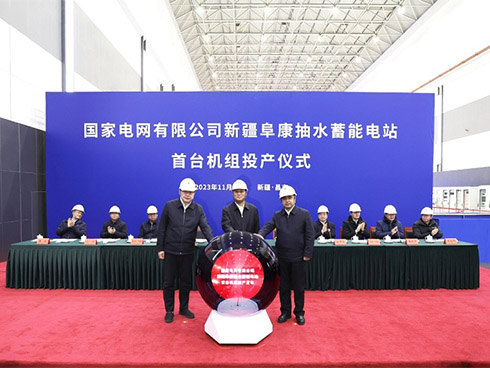
State Grid Corporation of China, China's largest state-owned grid operator and power company, has commissioned the Fukang pumped storage power station in northwest China's Xinjiang region. The plant is equipped with three 300 MW turbines for a total capacity of 1.2 GW, the company said in a press release, noting that the plant is the first of its kind in northwest China. It is said that these turbines will be put into operation in early 2024. Construction work started in October 2020. “The Fukang pumped storage power station can significantly improve Xinjiang’s power grid regulation capabilities and energy supply,” State Grid said. "It can ensure the stable transmission of large-scale new energy and can add 2.6 billion kilowatt-hours of new energy power generation every year." In January 2022, China’s largest pumped storage project, the 3.6 GW pumped storage power station in Fengning, Hebei Province, was put into operation. The US$1.87 billion project was started by China Gezhouba Engineering Company in 2014 and will be implemented in two phases with a total installed capacity of 1.8 GW. According to the National Energy Administration, China aims to have 62 GW of pumped hydro storage facilities operational by 2025 and 120 GW by 2030.
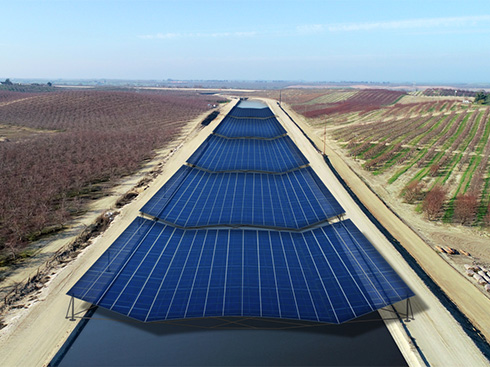
The Gila River Indian Community said it has signed an agreement with the U.S. Army Corps of Engineers to install solar panels on irrigation canals on its property south of Phoenix, Arizona. The first phase of the project will cover approximately 1,000 feet (304.8 meters) of irrigation canals to reduce water loss through evaporation. The project is expected to demonstrate the feasibility of solar canopy irrigation canals, with the potential to add additional construction length to community solar canopy canals in subsequent phases. The Army Corps of Engineers expects to complete construction on the first phase of the project in 2025. The investment cost of the first phase of the project is US$6.744 million, which will add 1 MW of solar power generation while reducing water evaporation in the irrigation canals. The project received US$517,000 in funding from the U.S. Bureau of Reclamation, and construction funds for the second phase of the project are also expected to come from the Bureau of Reclamation. The bureau is implementing a grant program established by Congress to pilot solar-powered irrigation canals.
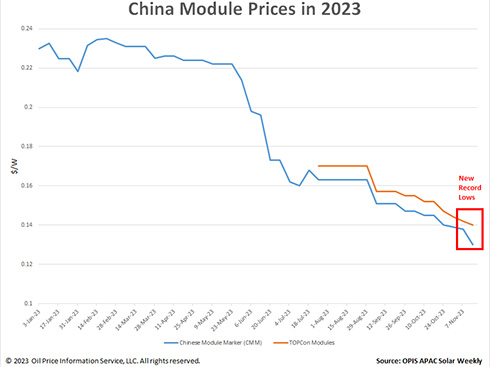
China Module Market (CMM) (the OPIS benchmark for monocrystalline PERC modules in China) and TOPCon module prices hit another record low this week, falling by $0.008/watt peak (wp) and $0.002/wp to $0.130 and $0.140/wp respectively. , according to OPIS data. Weak market sentiment and sluggish export demand continue to weigh on the component market. Module prices fell for a fourth straight week, with CMM falling by 5.8%, the largest percentage drop in more than two months. Most buyers and sellers are pricing monocrystalline PERC modules in the $0.120-130/wp range, while TOPCon modules are priced in the $0.130-140/wp range. One module seller said prices continued to fall. "Right now, we don't know how to predict module prices," he said. As the market is oversupplied, component manufacturers have reduced production, with one stakeholder estimating that the sector's overall operating rate is down 50-60% from the previous 70-80%. A component seller said that the company's current operating rate is around 60%. "At this stage, maintaining the current operating rate is sufficient," he said. He said that small factories with "inefficient production capacity" and unable to maintain production capacity will gradually withdraw from the market.
Categories
New Products
Tin Roof Rapid Solar Mounting System with Hanger Bolt Read More
Residential Small Solar Easy Bracket Kit for Home Balcony Read More
Automatic Single Pile Solar Tracker with 10 PV Panels Read More
Angle Adjustable Aluminum Easy Solar Panel Bracket for Garden Read More
Intelligent Single Post Dual Row Solar Tracking System Read More
5000ES Solar Off-Grid Energy Storage Inverter Supplier Read More
Multi Drive Double-Sided Single Axis Tracker System Read More
© Copyright: 2025 Xiamen Wintop New Energy Tech Co., Ltd.. All Rights Reserved.

IPv6 network supported
Friendly Links:
Integrated Solar System